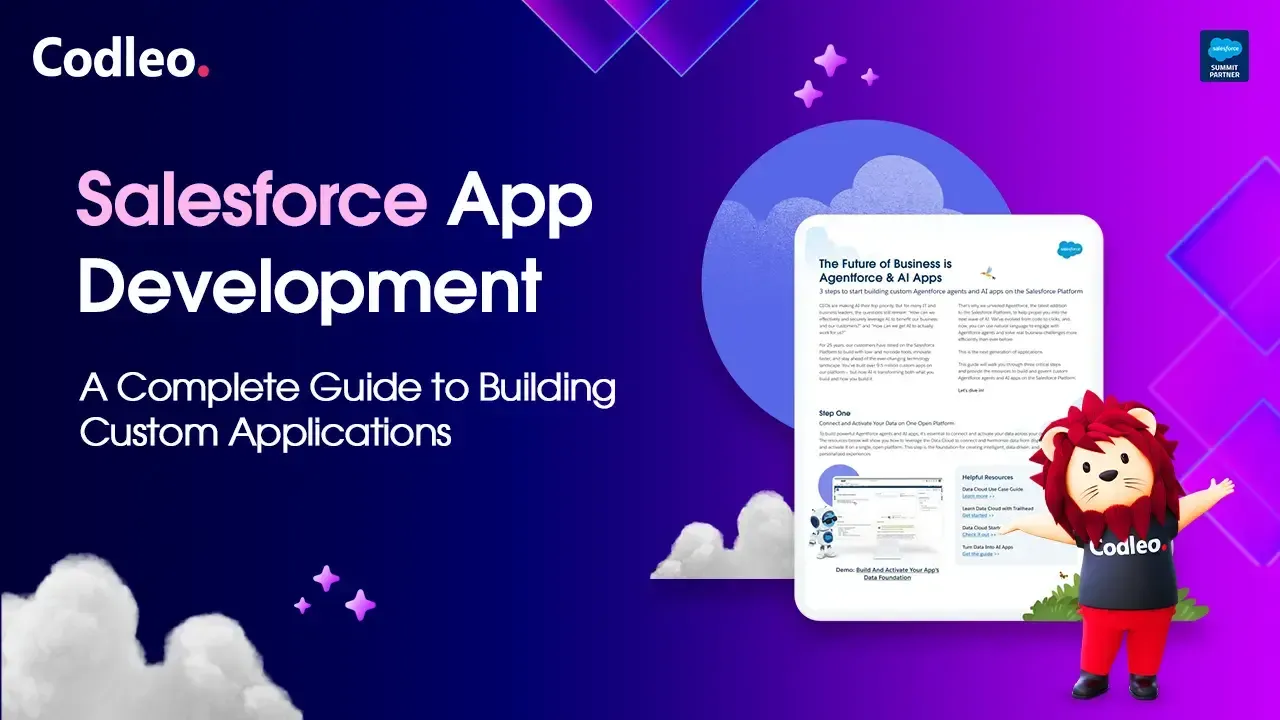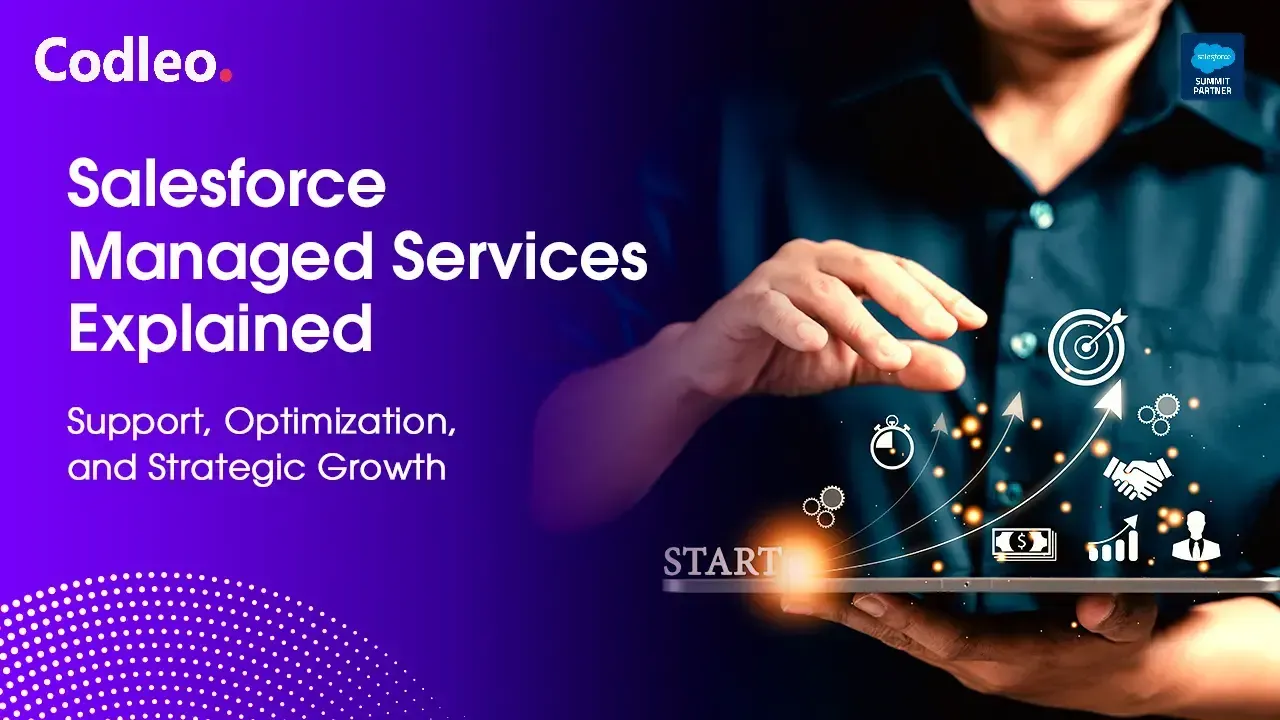Publish date:
Introducing Salesforce Manufacturing Cloud: the game-changing solution revolutionizing the manufacturing industry. In this comprehensive guide, we dive deep into the ins and outs of implementing Salesforce Manufacturing Cloud in 2026. Discover how this cutting-edge technology is transforming the way manufacturers operate and enabling them to thrive in today's competitive landscape.
Throughout this article, we explore the myriad benefits of Salesforce Manufacturing Cloud, including enhanced visibility and collaboration, streamlined production processes, and real-time data insights. We also delve into the best practices for a successful implementation, sharing expert tips and strategies to ensure a seamless transition and maximize the software's potential.
But what sets this guide apart is the inclusion of real-life success stories. We showcase how businesses across the globe have leveraged Salesforce Manufacturing Cloud to drive operational efficiency, boost sales, and meet customer demands effectively.
Whether you're a manufacturer considering Salesforce Manufacturing Cloud or a current user looking to optimize your implementation, this ultimate guide is your go-to resource. Empower your organization to embrace the future of manufacturing with Salesforce Manufacturing Cloud.
Introducing Salesforce Manufacturing Cloud
In today's rapidly evolving manufacturing landscape, staying competitive requires embracing innovative technologies that streamline operations and drive efficiency. Salesforce Manufacturing Cloud is one such game-changing solution that has revolutionized the industry. By providing manufacturers with enhanced visibility, streamlined production processes, and real-time data insights, Salesforce Manufacturing Cloud empowers organizations to thrive in the digital age.
Benefits of Implementing Salesforce Manufacturing Cloud
-
Implementing Salesforce Manufacturing Cloud offers a multitude of benefits for manufacturers. One of the key advantages is enhanced visibility across the entire supply chain. With Manufacturing Cloud, manufacturers gain real-time insights into inventory levels, production schedules, and customer demands. This visibility allows for better decision-making, optimized resource allocation, and improved production planning.
-
In addition to visibility, Salesforce Manufacturing Cloud also enables seamless collaboration between internal teams and external partners. By centralizing data and providing a single source of truth, Manufacturing Cloud breaks down silos and facilitates efficient communication. This collaboration leads to faster response times, reduced errors, and ultimately, improved customer satisfaction.
-
Moreover, Salesforce Manufacturing Cloud empowers manufacturers with real-time analytics and reporting capabilities. By leveraging the power of artificial intelligence and machine learning, the platform can analyze large volumes of data and provide actionable insights. These insights can drive operational efficiencies, identify areas for cost savings, and uncover hidden revenue opportunities.
Key Features of Salesforce Manufacturing Cloud
-
To fully understand the benefits of Salesforce Manufacturing Cloud, it is essential to explore its key features. One of the standout features is the Sales Agreement object, which allows manufacturers to align their sales and production plans seamlessly. By connecting sales forecasts with production capabilities, manufacturers can ensure optimal resource utilization and avoid stockouts or excess inventory.
-
Another notable feature is the Account-Based Forecasting functionality. This feature enables manufacturers to create customized forecasts for specific customer accounts, providing a more accurate picture of demand. By tailoring forecasts to individual accounts, manufacturers can better anticipate customer needs and proactively address them.
-
Additionally, Salesforce Manufacturing Cloud offers a robust set of analytics and reporting tools. Manufacturers can leverage pre-built dashboards and reports to gain insights into production performance, demand trends, and sales metrics. The platform also supports integration with external analytics tools, allowing for further customization and advanced data analysis.
Best Practices for Successful Implementation
Implementing Salesforce Manufacturing Cloud requires careful planning and execution to ensure a smooth transition and maximize its potential. Here are some best practices to follow for a successful implementation:
-
Define clear goals and objectives: Before embarking on the implementation journey, it is crucial to define clear goals and objectives. This will help align the implementation process with the organization's strategic vision and ensure that all stakeholders are on the same page.
-
Engage key stakeholders: Involving key stakeholders from different departments early on is essential for a successful implementation. This ensures that all perspectives and requirements are taken into account, and potential roadblocks are identified and addressed proactively.
-
Invest in proper training and change management: To fully capitalize on the benefits of Salesforce Manufacturing Cloud, it is vital to invest in comprehensive training for end-users. This will help them adapt to the new system and maximize its capabilities. Additionally, change management strategies should be implemented to ensure a smooth transition and minimize resistance to change.
-
Start with a pilot project. Implementing Salesforce Manufacturing Cloud across the entire organization at once can be overwhelming. Starting with a pilot project allows for testing and fine-tuning the system before scaling up. This approach also helps identify any potential challenges and allows for course correction early on.
-
Continuously monitor and optimize: Implementing Salesforce Manufacturing Cloud is not a one-time event but an ongoing process. It is essential to continuously monitor performance, gather feedback from users, and make necessary adjustments to optimize the system's effectiveness.
Step-by-Step Guide to Implementing Salesforce Manufacturing Cloud
Now that we have explored the benefits and best practices, let's walk through a step-by-step guide to implementing Salesforce Manufacturing Cloud:
-
Assess your current processes: Before implementing Salesforce Manufacturing Cloud, assess your current manufacturing processes, identifying pain points, and areas for improvement. This assessment will help determine the specific functionalities and features you need to focus on during implementation.
-
Define your data model: Design a data model that aligns with your organization's unique requirements. This includes determining the specific objects, fields, and relationships that need to be configured within the Salesforce Manufacturing Cloud.
-
Configure Salesforce Manufacturing Cloud: Utilize the powerful configuration tools within Salesforce Manufacturing Cloud to set up the system according to your defined data model. This includes creating custom objects, fields, and workflows, as well as configuring user permissions and access controls.
-
Integrate with existing systems: Integrate Salesforce Manufacturing Cloud with your existing systems, such as ERP or MES systems, to ensure seamless data flow and synchronization. This integration will enable real-time visibility and ensure accurate data across all systems.
-
Train end-users and stakeholders: Provide comprehensive training to end-users and stakeholders to familiarize them with Salesforce Manufacturing Cloud's capabilities and workflows. This training should cover basic system navigation, data entry, reporting, and analytics.
-
Perform thorough testing: Before going live, thoroughly test all configurations and integrations to ensure that the system is functioning as expected. This testing should include end-to-end scenarios, data validation, and user acceptance testing.
-
Go live and monitor performance: Once all testing is complete, it's time to go live with Salesforce Manufacturing Cloud. Monitor the system's performance closely during the initial implementation phase, addressing any issues or concerns promptly.
-
Continuously optimize and refine: After the initial implementation, continuously gather feedback from end-users and stakeholders to identify areas for improvement. Regularly review and refine your processes, workflows, and configurations to maximize the value of Salesforce Manufacturing Cloud.
Common Challenges and How to Overcome Them
While implementing Salesforce Manufacturing Cloud offers numerous benefits, it is essential to be aware of common challenges that organizations may face during the process. Here are some challenges and strategies to overcome them:
-
Resistance to change: Resistance to change is a common challenge during any technology implementation. To overcome this, it is crucial to invest in change management strategies, such as clear communication, training, and involving key stakeholders from the beginning.
-
Data migration and integration: Migrating and integrating data from existing systems can be complex. To address this challenge, organizations should invest in robust data migration tools and engage experienced consultants who specialize in data integration.
-
Lack of expertise: Implementing Salesforce Manufacturing Cloud requires expertise in both manufacturing processes and the Salesforce platform. To overcome this challenge, organizations can leverage the expertise of implementation partners or invest in training and upskilling their internal teams.
-
Scaling and customization: As organizations grow and evolve, they may face challenges in scaling and customizing Salesforce Manufacturing Cloud to meet their changing needs. To address this, organizations should regularly review and optimize their configurations, workflows, and integrations, ensuring they align with their evolving business requirements.
By being aware of these challenges and proactively addressing them, organizations can ensure a successful implementation and maximize the value of Salesforce Manufacturing Cloud.
Training and Resources for Salesforce Manufacturing Cloud Implementation
To support organizations in their Salesforce Manufacturing Cloud implementation journey, Salesforce provides a range of training and resources. These include:
-
Trailhead: Salesforce's online learning platform, Trailhead, offers a variety of modules and trails specifically designed for Salesforce Manufacturing Cloud. These modules cover various topics, from basic system navigation to advanced analytics and reporting.
-
Salesforce Community: The Salesforce Community is a valuable resource for connecting with other Salesforce Manufacturing Cloud users, sharing best practices, and seeking advice from experts. It provides a platform for collaboration and learning from the experiences of other organizations.
-
Salesforce Consulting Partners: Salesforce has a network of certified consulting partners who specialize in Salesforce Manufacturing Cloud implementation. These partners can provide expertise and guidance throughout the implementation process, ensuring a successful outcome.
-
Salesforce Help and Documentation: Salesforce offers comprehensive documentation and guides for Salesforce Manufacturing Cloud, covering various topics, such as implementation, configuration, and troubleshooting. These resources provide step-by-step instructions and best practices for a successful implementation.
By leveraging these training and resources, organizations can equip themselves with the knowledge and support needed to implement Salesforce Manufacturing Cloud effectively.
Maximizing the ROI of Salesforce Manufacturing Cloud
To maximize the return on investment (ROI) of Salesforce Manufacturing Cloud, organizations should focus on the following strategies:
-
Continuous improvement: Regularly review and optimize processes, workflows, and configurations to ensure they align with changing business needs. This continuous improvement mindset will help organizations stay ahead of the curve and maximize the value of Salesforce Manufacturing Cloud.
-
Leverage advanced analytics: Explore the advanced analytics and reporting capabilities of Salesforce Manufacturing Cloud to gain deeper insights into production performance, demand trends, and sales metrics. By leveraging these insights, organizations can identify areas for improvement and make data-driven decisions.
-
Integrate with other Salesforce products: Salesforce offers a suite of products that complement Salesforce Manufacturing Cloud, such as Sales Cloud and Service Cloud. By integrating these products, organizations can create a unified ecosystem that provides end-to-end visibility and seamless collaboration across departments.
-
Embrace emerging technologies: Stay up to date with emerging technologies and explore how they can be integrated with the Salesforce Manufacturing Cloud. Technologies such as the the Internet of Things (IoT) and artificial intelligence (AI) can further enhance operational efficiency and drive innovation in the manufacturing process.
By implementing these strategies, organizations can ensure they are maximizing the ROI of Salesforce Manufacturing Cloud and driving long-term success.
Conclusion
Salesforce Manufacturing Cloud is a game-changing solution that empowers manufacturers to thrive in today's competitive landscape. By providing enhanced visibility, streamlined production processes, and real-time data insights, Salesforce Manufacturing Cloud enables organizations to make informed decisions, collaborate effectively, and meet customer demands efficiently.
In this ultimate guide, we have explored the benefits, key features, and best practices for implementing Salesforce Manufacturing Cloud. We have also showcased real-life success stories and provided strategies to overcome common challenges. By following the step-by-step guide and leveraging the available training and resources, organizations can ensure a successful implementation and maximize the ROI of Salesforce Manufacturing Cloud.
Embrace the future of manufacturing with Salesforce Manufacturing Cloud and drive operational efficiency, boost sales, and meet customer demands effectively. Get ready to revolutionize your manufacturing processes and position your organization for long-term success in 2026 and beyond.















